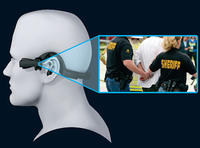-
Taser rolls out redesigned wearable cameras

Last week Taser, the manufacturers of the electric stun guns, unveiled its newly remodeled wearable camera system which is sleeker and more advanced than its predecessor; the Axon Flex, introduced less than a year after the company rolled out its first wearable cameras, represents a significant upgrade
-
-
U.S. Navy tests electromagnetic railgun launcher

The electromagnetic railgun launcher is a long-range weapon that fires projectiles using electricity instead of chemical propellants; magnetic fields created by high electrical currents accelerate a sliding metal conductor, or armature, between two rails to launch projectiles at 4,500 mph to 5,600 mph; the new railgun will allow the U.S. Navy to conduct precise, long-range naval surface fire support for land strikes, ship self-defense against cruise and ballistic missiles, and surface warfare to deter enemy vessels
-
-
Trinity University students help raise bomb sniffing dog
With the help of students at Trinity University in San Antonio, Texas, Jjurgens is being trained to fight against terrorism; Jjurgens, a four-month old yellow Labrador retriever, is the only dog in the United States being fostered at a university or school under the Transportation Security Administration Canine Breeding and Development Center program
-
-
N.Y. senator pushes to streamline industrial fire regulations

Last week Senator Charles Schumer (D – New York) urged the Environmental Protection Agency (EPA) to make it easier for first responders to contain industrial fires at chemical facilities by streamlining the agency’s reporting process
-
-
Detecting explosives from a distance with laser beams
Scientists have found a way to detect chemicals over long distances, even if they are enclosed in containers; the scientists tested the system by trying to detect frequently used explosives, such as TNT, ANFO, or RDX from a distance – and the tests were successful
-
-
New York overhauls emergency response capabilities post-Irene

Last week New York Governor Andrew Cuomo proposed a series of major initiatives to bolster the state’s emergency response capabilities; the proposals specifically incorporate lessons learned from the state’s response to Hurricane Irene and Tropical Storm Lee
-
-
Rats trained to detect explosives
Bomb sniffing dogs could be a thing of the past thanks to explosives seeking rats; unlike dogs, when rats detect sensitive explosives like land mines they rarely set them off as they weigh less than pound
-
-
London holds massive Olympic security drill

Last week, in preparation for the London 2012 Olympic Games, more than 2,500 government officials, local police, and emergency responders participated in a two-day long emergency drill that simulated a terrorist attack on the city’s transportation network
-
-
Anthrax-decontamination foam used in meth lab cleanup
The meth cleanup problem in the United States is a big one; the U.S. Drug Enforcement Administration lists thousands of locations where law enforcement agencies have found chemicals or paraphernalia indicating the presence of either clandestine drug laboratories or dumpsites; Sandia’s decontamination foam, originally developed to deal with anthrax, is now also a meth eraser
-
-
SOUTHCOM deploys radar that sees through foliage, rain, darkness, and dust storms
Lockheed Martin’s TRACER is a light weight, low-frequency synthetic-aperture radar that can peer through foliage, rain, darkness, dust storms, or atmospheric haze to provide real-time, high-quality tactical ground imagery; U.S. Southern Command has just deployed the penetrating radar to support the Command’s counter-terrorism and humanitarian assistance missions, and disaster relief operations
-
-
Study finds use of GPS jammers across U.K.
A new study by Chronos Technology reveals that GPS jamming devices are relatively common in the United Kingdom
-
-
End of Utah’s chemical weapons stockpile signals end of federal grants

As the last of Utah’s chemical weapons stockpile is destroyed, the millions of dollars that have flowed into the state from federal grants will begin to disappear along with thousands of jobs
-
-
Demand for Israeli security solutions remains strong -- and is growing
Homeland Security NewsWire’s executive editor Eugene K. Chow recently spoke with Koby Tanzer, a partner at Indigo Strategic Partners, an investment firm that specializes in the Israeli security and defense sector; in the interview, Tanzer discusses Indigo’s investment philosophy, how the global recession has affected defense and homeland security spending, trends in the global homeland security market, mobile device-based security solutions, and more
-
-
One in three of military aircraft are drones
A report by the Congressional Research Service (CRS) recently made public reveals that unmanned drones now account for 31 percent of all military aircraft
-
-
Surveillance truck helps Fort Lauderdale keep streets safe
Police in Fort Lauderdale, Florida are trying a new approach to fighting crime – blatantly telling criminals they are under surveillance
-
More headlines
The long view
Why Ukraine’s AI Drones Aren’t a Breakthrough Yet
By David Kirichenko
Machine vision, a form of AI, allows drones to identify and strike targets autonomously. The drones can’t be jammed, and they don’t need continuous monitoring by operators. Despite early hopes, the technology has not yet become a game-changing feature of Ukraine’s battlefield drones. But its time will come.
